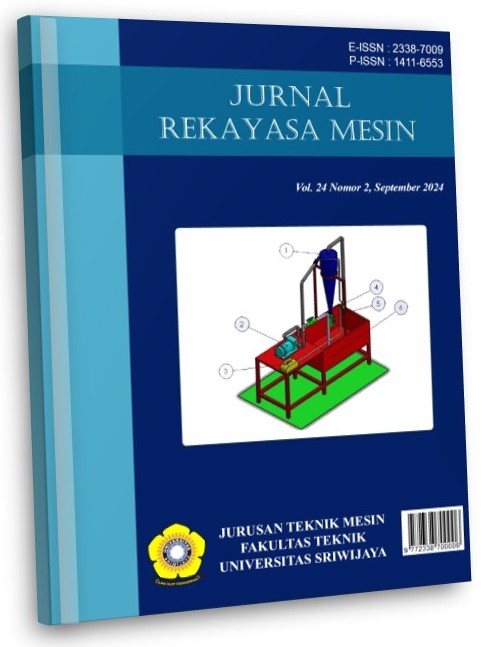Analisis Struktur Kursi Roda Multi Guna menggunakan Finite Elemen Analisis dan Analitik
DOI:
https://doi.org/10.36706/jrm.v24i2.1066Keywords:
multipurpose wheelchair, finite element analysis, structural analysisAbstract
This research aims to analyze the performance of multi-purpose wheelchair structures using the finite element method (FEA) and analytical calculations. A wheelchair model was built and analyzed using FEA software to obtain stress, displacement and bending stress distributions. The FEA results show a maximum stress value of 415 MPa, a maximum displacement of 46 mm, and a maximum bending stress of 407 MPa, exceeding the mechanical properties limit of 6061 aluminum material. The analytical results produce a stress value of 57 MPa in the front structure, while the FEA produces a value of 46 MPa. The difference in results between these two methods can be caused by several factors, such as the assumptions used in analytical calculations and the geometric complexity of the FEA model. The conclusion we can draw from this research is that the design/structure of the multi-purpose wheelchair has exceeded the mechanical property values of the Aluminum 6061 material, which can cause structural failure in the components when fabricated.
Downloads
References
M. R. Haholongan and M. Subroto, “Pelayanan Kesehatan dan Pembinaan Khusus terhadap Narapidana Penyandang Disabilitas dalam Pemenuhan HAM di Lembaga Pemasyarakatan,” J. Pendidik. Tambusai, vol. 5, pp. 6131–6137, 2021, [Online]. Available: https://jptam.org/index.php/jptam/article/view/1922
I. T. Anggoro, R. D. Purwaningrum, N. A. B. Prakoso, A. Rahmawati, R. A. Apriani, and M. Arifai, “Inovasi kursi roda fleksibel berdasarkan otonom sistem cerdas untuk penyandang cacat dan lansia menggunakan metode PDCA,” Semin. dan Konf. Nas. IDEC 2022, p. A12.1-A12.5, 2022.
H. Soewardi and M. K. A. Afgani, “Innovative Design of Ergonomic Wheelchair for Disabled People,” in IOP Conference Series: Materials Science and Engineering, 2019. doi: 10.1088/1757-899X/598/1/012033.
M. Z. Mistarihi, R. A. Okour, and A. A. Mumani, “An integration of a QFD model with Fuzzy-ANP approach for determining the importance weights for engineering characteristics of the proposed wheelchair design,” Appl. Soft Comput. J., 2020, doi: 10.1016/j.asoc.2020.106136.
C. W. Chen and D. C. Cai, “A wheelchair design for topple prevention,” in Applied Mechanics and Materials, 2014. doi: 10.4028/www.scientific.net/AMM.590.561.
J. Rui and Q. Gao, “Design and Analysis of A Multifunctional Wheelchair,” in IOP Conference Series: Materials Science and Engineering, 2019. doi: 10.1088/1757-899X/538/1/012045.
T. J. Liu, J. Liang, W. Chen, T. Chen, and A. W. Frame, “Finite Element Analysis of Composite Frames in Wheelchair under Upward Loading,” vol. 8, no. 1, pp. 1–6, 2014.
S. Kalyanasundaram, A. Lowe, and A. J. Watters, “Finite element analysis and optimization of composite wheelchair wheels,” Compos. Struct., 2006, doi: 10.1016/j.compstruct.2006.04.011.
L. S. Marques, R. R. Magalhães, D. A. de Lima, J. E. Tsuchida, D. C. Fuzzato, and E. T. de Andrade, “Finite element analysis of a commercial wheelchair,” Disabil. Rehabil. Assist. Technol., vol. 16, no. 8, pp. 890–901, Nov. 2021, doi: 10.1080/17483107.2020.1749893.
P. Antropometri, “Dimensi antropometri 1.,” pp. 1–18.
T. Hong, F. Ding, F. Chen, H. Zhang, Q. Zeng, and J. Wang, “Mechanical Properties of 6061 Aluminum Alloy under Cyclic Tensile Loading,” Crystals, 2023, doi: 10.3390/cryst13081171.
J. H. Argyris, M. Haase, and H. P. Mlejnek, “On an unconventional but natural formation of a stiffness matrix,” Comput. Methods Appl. Mech. Eng., 1980, doi: 10.1016/0045-7825(80)90048-1.
Downloads
Published
How to Cite
Issue
Section
License
Copyright (c) 2024 Jurnal Rekayasa Mesin

This work is licensed under a Creative Commons Attribution-ShareAlike 4.0 International License.
Jurnal Rekayasa Mesin (JRM) memberikan akses terbuka terhadap siapapun agar informasi dan temuan pada artikel tersebut bermanfaat bagi semua orang. Semua konten artikel Jurnal ini dapat diakses dan diunduh secara gratis, tanpa dipungut biaya, sesuai dengan lisensi creative commons yang digunakan.





















